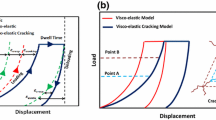Abstract
Stress–Strain plots based on nanoindentation load–depth curves were obtained to study phenomena like internal fracture and ductile to brittle transitions. Fracture phenomena during the indentation process were analyzed based on the stress–strain plots. A transition from ductile to brittle fracture was observed on increasing the depth or load of indenter penetration. A new approach with shape factors in the fracture studies based on radial crack branching and micro-cracking was done. Hardness and modulus plots were fitted with polynomials. The fitting parameters were varied to obtain different hardness and modulus responses.




















Similar content being viewed by others
References
A.C. Fischer-Cripps, Nanoindentation, Springer, NewYork, 2004
W.C. Oliver and G.M. Pharr, An Improved Technique for Determining Hardness and Elastic Modulus Using Load and Displacement Sensing Indentation Experiments, J. Mater. Res., 1992, 7, p 1564
J. Malzbender, J.M.J. den Toonder, A.R. Balkenende, and G. de With, Measuring Mechanical Properties of Coatings: A Methodology Applied to Nano-Particle-Filled sol–gel Coatings on Glass, Mater. Sci. Eng. Rep., 2002, 36, p 47
R. Abram, D. Chrobak, and R. Nowak, Origin of a Nanoindentation Pop-in Event in Silicon Crystal, Phys. Rev. Lett., 2017, 118, p 095502
S. Wong, B. Haberl, J.S. Williams, and J.E. Bradby, The Influence of Hold Time on the Onset of Plastic Deformation in Silicon, J. Appl. Phys., 2015, 118, p 245904
A.S. Bhattacharyya and S.K. Mishra, Raman Studies on Nanocomposite Silicon Carbonitride Thin Film Deposited by RF Magnetron Sputtering at Different Substrate Temperatures, J. Raman Spectrosc., 2010, 41, p 1234–1239
A.S. Bhattacharyya, S.K. Mishra, and S. Mukherjee, Correlation of Structure and Hardness of RF Magnetron Sputtered Silicon Carbonitride Films, J. Vac. Sci. Technol. A, 2010, 28, p 505–509
A.S. Bhattacharyya, S.K. Mishra, S. Mukherjee, and G.C. Das, A Comparative Study of Si-C-N Films on Different Substrates Grown by RF Magnetron Sputtering, J. Alloys Compd., 2009, 478, p 474–478
A.S. Bhattacharyya, G.C. Das, S. Mukherjee, and S.K. Mishra, Effect of Radio Frequency and Direct Current Modes of Deposition on Protective Metallurgical Hard Silicon Carbon Nitride Coatings by Magnetron Sputtering, Vacuum, 2009, 83, p 1464–1469
W.C. Oliver and G.M. Pharr, Measurement of Hardness and Elastic Modulus by Instrumented Indentation: Advances in Understanding and Refinements to Methodology, J. Mater. Res., 2004, 19, p 3
Z. Cao and X. Zhang, Nanoindentation Stress–Strain Curves of Plasma-Enhanced Chemical Vapor Deposited Silicon Oxide Thin Films, Thin Solid Films, 2008, 516, p 1941–1951
S. Zhang, H.L. Wang, S.-E. Ong, D. Sun, and X.L. Bui, Hard yet Tough Nanocomposite Coatings—Present Status and Future Trends, Plasma Process. Polym., 2007, 4, p 219–228
A.S. Bhattacharyya, R.P. Kumar, V. Ranjan, and G. Kumar, Nanoindentation and Scratch test of Thin Film Energy Materials, Curr. Smart Mater., 2017, 2, p 39–43
A.S. Bhattacharyya and S.K. Mishra, Micro/Nanomechanical Behavior of Magnetron Sputtered Si-C-N Coatings Through Nanoindentation and Scratch Tests, J. Micromech. Microeng., 2011, 21, p 015011
E. Mart´ınez, J. Romero, A. Lousa, and J. Esteve, Nanoindentation Stress–Strain Curves as a Method for Thin-Film Complete Mechanical Characterization: Application to Nanometric CrN/Cr Multilayer Coatings, Appl. Phys. A, 2003, 77, p 419–426. https://doi.org/10.1007/s00339-002-1669-0
S.K. Mishra, A.S. Bhattacharyya, P. Mahato, and L.C. Pathak, Multicomponent TiSiBC Superhard and Tough Composite Coatings by Magnetron Sputtering, Surface Coat. Technol., 2012, 207, p 19–23
S.J. Bull, Nanoindentation of Coatings, J. Phys. D Appl. Phys., 2005, 38, p R393–R413
J.M.J. den Toonder, J. Malzbender, G. de With, and R. Balkenende, Fracture Toughness and Adhesion Energy of Sol-Gel Coatings on Glass, J. Mater. Res., 2002, 17, p 224
A.S. Bhattacharyya, P. Kumar, N. Rajak, R.P. Kumar, A. Sharma, G. Acharya, and V. Ranjan, Analyzing Time on Sample during Nanoindentation, Mater. Sci. Res. India, 2016, 13(2), p 74–79
Z. Burghard, Behaviour of glasses and polymer-derived amorphous ceramics under contact stress, PhD-Thesis, Max-Planck Institute for Metals Research & University of Stuttgart Germany
Z.D. Sha, Q. Wan, Q.X. Pei, S.S. Quek, Z.S. Liu, Y.W. Zhang, and V.B. Shenoy, On the Failure Load and Mechanism of Polycrystalline Graphene by Nanoindentation, Sci. Rep., 2014, 4, p 7437
N. Cuadrado, J. Seuba, D. Casellas, M. Anglada, and E. Jiménez-Piqué, Geometry of Nanoindentation Cube-Corner Cracks Observed by FIB Tomography: Implication for Fracture Resistance Estimation, J. Eur. Ceram. Soc., 2015, 35, p 2949–2955
A.S. Bhattacharyya, S.K. Mishra, G.C. Das, and S. Mukherjee, Hot Properties, Eur. Coat. J., 2009, 3, p 108–114
Alireza Moradkhani, Hamidreza Baharvandi, Mehdi Tajdari, Hamidreza Latifi, and J. Martikainen, Determination of Fracture Toughness Using the Area of Micro-Crack Tracks Left in Brittle Materials by Vickers Indentation Test, J. Adv. Ceram., 2013, 2(1), p 87–102
S.K. Mishra and A.S. Bhattacharyya, Adhesion and Indentation Fracture Behavior of Silicon Carbonitride Nanocomposite Coatings Deposited by Magnetron Sputtering, Silicon-based Nanomaterials, Springer Series in Materials Science, chap. 10, vol. 187, Springer, New York, 2013, p 215–241
A.S.Bhattacharyya, S Priyadarshi, S. Sonu, S. Shivam, and S. Anshu, Nanoindentation Stress–Strain for Fracture Analysis and Computational Modeling for Hardness and Modulus, arXiv:1704.04525 [cond-mat.mtrl-sci]
Acknowledgments
The authors acknowledge Dr. S. K. Mishra for carrying out the experimental work at CSIR-National Metallurgical Laboratory, Jamshedpur. The article is self-archived in arXiv.org (Ref 26).
Author information
Authors and Affiliations
Corresponding author
Additional information
This article is an invited paper selected from presentations at “ICETINN-2017, International Conference on Emerging Trends in Nanoscience and Nanotechnology,” held March 16–18, 2017, in Majitar, Sikkim, India, and has been expanded from the original presentation.
Rights and permissions
About this article
Cite this article
Bhattacharyya, A.S., Kumar, R.P., Priyadarshi, S. et al. Nanoindentation Stress–Strain for Fracture Analysis and Computational Modeling for Hardness and Modulus. J. of Materi Eng and Perform 27, 2719–2726 (2018). https://doi.org/10.1007/s11665-018-3289-7
Received:
Revised:
Published:
Issue Date:
DOI: https://doi.org/10.1007/s11665-018-3289-7




